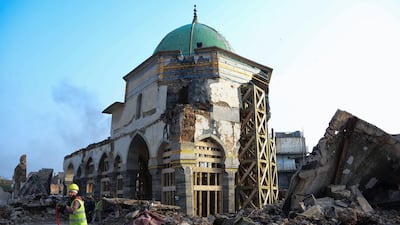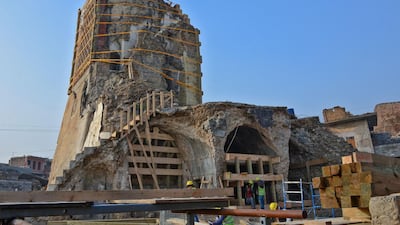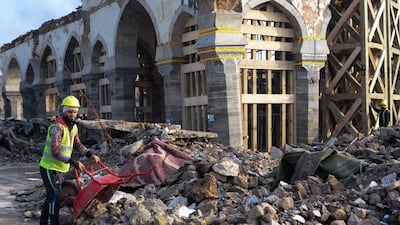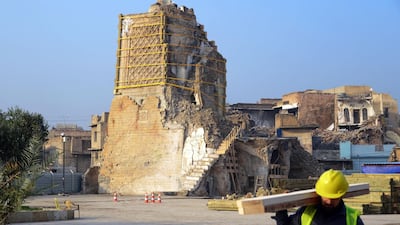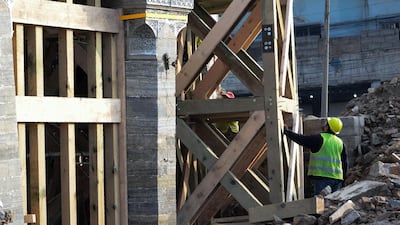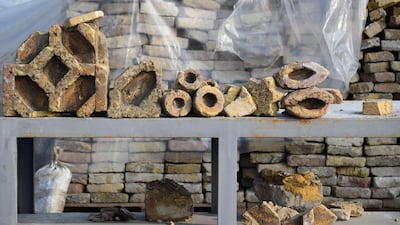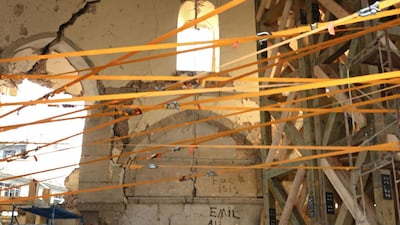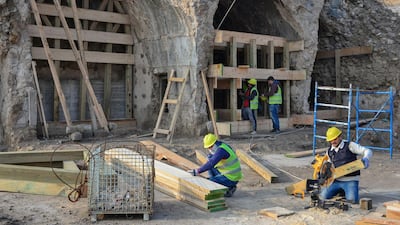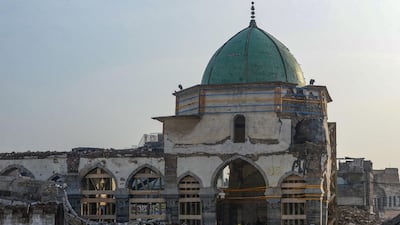The majority of residents of Mosul would like to see the Al Nuri Mosque and its iconic leaning minaret restored exactly as they appeared, before being destroyed by ISIS in 2017.
The two landmarks are being reconstructed through a UAE-UNESCO project, and residents were asked for their views in a survey.
For centuries, the 12th century mosque and it’s leaning minaret, nicknamed “the hunchback” or “Al Hadba”, have been one of the city’s best-known sights.
More than 700 Moslawis took part in the survey, which was conducted by the University of Mosul’s Statistical Consultancy Bureau in cooperation with UNESCO.
Moslawis of all ages, backgrounds and genders were asked about how would they like to see the mosque’s prayer hall and the minaret rebuilt.
Ninety-four per cent of those surveyed said they would like to see the minaret as it was in 2017, with the same decoration and position, while 83 per cent of them wanted it to retain its famous leaning angle.
For the prayer hall, 70 per cent of Moslawis wanted it to remain as it was, with some improvements, and only 28 per cent wanted to keep the same previous details, with no changes.
The project to revive Mosul’s heritage and cultural sites has been subject to much debate within Mosul on how to proceed.
"I honestly would like to see the space much bigger, and I want to see the prayer hall larger so it can have more people," said Omar Mohammed, the founder of the None-Governmental Organisation Mosul Eye, to The National.
Mosul Eye became known internationally after 2014 as a defiant, anonymous online account of life inside the city under ISIS occupation.
Although the leaning aspect of the minaret is historically a technical error, Mr Mohammed said: “If the people want it be leaning because it was attached to the identity of the people then yes, if it is possible, we can have it a leaning minaret, but it will not be original of course.”
“Therefore, I would like to see a completely new minaret based on the same architecture and design. We need for sure to keep the mosque alive by establishing a cultural centre connected to it.”
But some expressed their objections, during an event on the survey.
Retired history professor Jazeel Abdul Jabar Al Jumrid, said that a voice that represents the city’s experts and educated people is absent from the reconstruction effort.
“More people should be consulted or should have participated in the survey, especially experts, university professors and other educated people, and not only the simple ones,” Mr Al Jumrid said.
“First, we need to identify the value and place of this site in the city’s culture, have all opinions not only from one segment, and that will lead us to a unified social vision for rebuilding it,” he added.
Mosul was the biggest city to fall into the hands of ISIS militants during their blitz in mid-2014 when they controlled vast areas not only in Iraq, but also in neighbouring Syria.
Shortly after controlling Mosul and surrounding areas, ISIS fanatics started demolishing anything – including ancient heritage – which they regarded as heresy.
They blew up priceless, centuries-old archaeological sites, and ransacked and burned down libraries. They also profited from smuggling and selling antiquities on the international black market.
The then leader of ISIS, Abu Bakr Al Baghdadi, made an infamous speech on July 2014 from the mosque’s pulpit, during which he proclaimed the group had founded a new caliphate.
As government forces approached Mosul Old City in June 2017, the last urban stronghold for ISIS, the militants blew up Al Nuri Mosque and its minaret, in a message of defiance.
The UNESCO flagship initiative “Revive the Spirit of Mosul” was launched early in 2018, a few months after the declaration of victory over ISIS, following more three-years of devastating war, which left major cities in ruins.
The UAE has pledged $50.4 million (Dh185m) to restore the Al Nuri complex, as well as two old churches, Al Saa’a and Al Tahera.
The initiative aims at recovering the city’s iconic buildings and heritage sites, while also strengthening the educational system, through rehabilitating and repairing schools. With a focus on reforming curriculums and supporting local cultural initiatives, the project also aims to restore the city’s intellectual life.
It also covers the reconstruction of houses, schools, an old market, Mosul University’s Central Library and the Nabi Younis shrine, also known as the Biblical tomb of Jonah.
There has also been some progress in the work on the Al Nuri complex. Critical initial assessments have been completed, the sites have been secured and rubble has been removed. Historical fragments have also been collected, and the remaining structures have been stabilised.
UNESCO is also expected to announce in April the winning design entry in an international design competition for reconstruction and rehabilitation of the complex around the mosque.
At Al Tahera church, rubble has been removed, fencing and security cameras have been installed and security guards have been employed. And last week, work began to clear the rubble and landmines planted by ISIS at Al Saa’a church.
